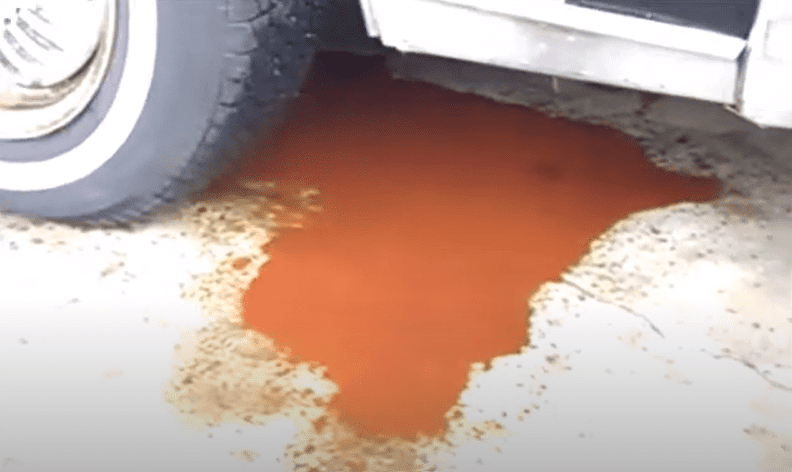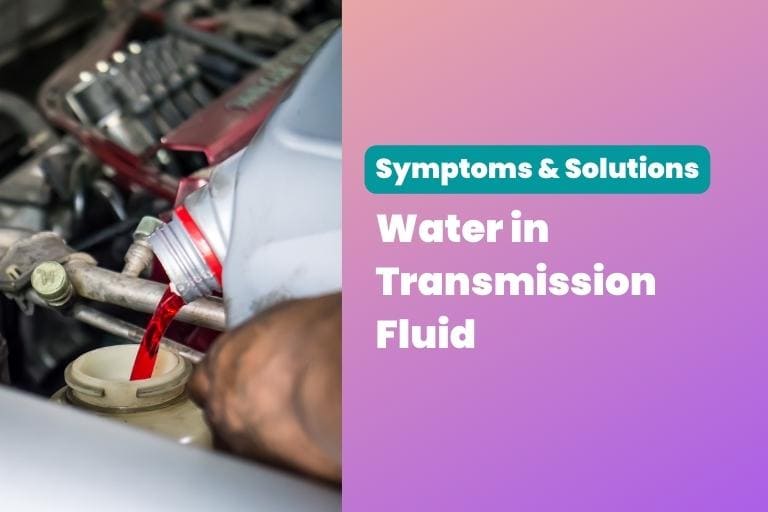Transmission fluid is vital in keeping your vehicle running smoothly, and contamination can lead to severe problems.
This blog will discuss water’s symptoms in transmission fluid, which can occur when water enters the transmission system. We will also explain the potential dangers of having water in transmission fluid and why it is crucial to address any issues as soon as they arise.
Water in the transmission fluid can cause damage to the transmission, leading to costly repairs or even replacement. By understanding the symptoms and potential dangers, you can take steps to protect your vehicle and ensure it runs smoothly for years to come.
Let us dive into the article and try to know everything in detail.
Contents
How Water Can Get Into Transmission Fluid
Understanding the various pathways through which water infiltrates transmission fluid is essential for vehicle longevity. Such contamination spells trouble for your car’s transmission system and can be highly destructive if not addressed promptly.
- Engine Radiator Complications: A damaged radiator can allow coolant to mix with the transmission fluid. Specifically, a compromised internal trans cooler within the engine radiator could result in coolant contaminating the fluid in the automatic transmission.
- Adventures in Deep Water: Engaging in off-roading activities or driving through flooded areas can cause water to be sucked into the transmission system. The extent of the damage can be exacerbated if the vehicle’s transmission vent is poorly positioned.
- Exposure to Environmental Moisture: A vehicle parked outdoors can absorb water through the dipstick tube, especially in regions prone to high barometric pressure, rain, or humidity. Check your transmission fluid level frequently if your vehicle’s parking spot exposes it to such conditions.
Vulnerability Factors:
- Location-Specific Risks: Vehicles routinely driven in wet or flood-prone zones are more susceptible to water infiltration into the transmission fluid.
- Heavy-Duty Usage: The transmission fluids before the engine start may already be susceptible in vehicles meant for rigorous tasks like off-roading.
- Age and Wear: Older models or cars with damaged seals and gaskets may need for a transmission rebuild as they are prone to fluid changes that allow water to enter. Regular fluid checks and overhauls can improve the chances of saving the transmission.
The presence of water in transmission fluid is not just an inconvenience but a critical issue that can cause rust on clutch plates, impact the friction lining, and ultimately damage parts in the transmission. If water gets inside the unit, immediate steps such as a thorough flush can mitigate the risks and minimize the need for a costly overhaul.
Symptoms of Water in Transmission Fluid

- White gummy masses forming in various areas of the unit: The presence of white gummy masses in the transmission indicates water contamination. These masses are formed due to water mixing with transmission fluid, causing it to emulsify and form a gel-like substance.
- Transmission fluid becoming grey and muddy in color: Transmission fluid contaminated with water will appear cloudy or murky, as opposed to its typical red or pink hue. This is a clear indication that water has entered the transmission system.
Water can cause damage to the transmission over time by corroding and rusting internal parts, leading to increased friction and wear. Water can also decrease the lubrication properties of the transmission fluid, which can cause further damage.
It can also lead to slipping gears, rough shifting, transmission overheating, and loss of power. Over time, it can cause severe damage to the transmission, including internal component failure.
This can significantly reduce the transmission’s longevity, resulting in costly repairs or replacement. It is crucial to address any issues with water contamination as soon as they are noticed to prevent further damage and prolong the life of the transmission.
Consequences Of Water Foaming in Transmission Fluid
- Mandatory Fluid Replacement: In the most optimistic scenario, early water contamination detection would necessitate merely a new transmission fluid flush. Replacing the compromised fluid can arrest further damage to the transmission system, extending its service life.
- Transmission Overhaul or Replacement: Should the water intrusion escape early detection, you might be steering towards a more burdensome pathway: the overhaul or complete replacement of your transmission. While undeniably costly, this step can still save your vehicle from succumbing to a catastrophic failure.
- Complete Vehicle Replacement: The gravest outcome looms when water foaming is left unchecked or the incurred damage spirals beyond repair. In such cases, you’ll face the stark reality of needing a new vehicle altogether. This can be particularly financially devastating if your existing vehicle is relatively new or holds significant value.
For the sake of your vehicle’s transmission system—and your wallet—it’s imperative to remain proactive with periodic checks and maintenance. Being vigilant often means distinguishing between a manageable repair and a financially crippling replacement.
Key Takeaway: Water contamination in transmission fluid is more than a minor hiccup; it’s a ticking time bomb that can unleash a cascade of problems, from transmission wear to complete vehicle failure. Regular checks and prompt action can be your best allies in minimizing these risks.
What to Do if Water Is Present in Transmission Fluid
- If water is suspected, get the vehicle to the repair shop immediately: If you suspect that water has entered the transmission fluid, getting the vehicle to a repair shop as soon as possible is vital. The longer you wait, the more damage can be done to the transmission.
- Do not start the engine; have the vehicle towed instead: Starting the engine can cause further damage to the transmission. It is crucial to have the vehicle towed to the repair shop to prevent further damage.
- Changing transmission fluids before the engine starts improves the chances of saving the car: If water contamination is caught early, changing the transmission fluid before the engine can improve the chances of saving the vehicle. It is important to note that a professional should only do this, as it is a complex process.
- Recommendation for regular transmission fluid checks and changes: Regularly checking and changing the fluid can help prevent water contamination and prolong the life of the transmission. Transmission fluid should be checked and replaced every 30,000 to 60,000 miles, as the manufacturer suggests. Regular check-ups can help spot any problems early on, saving you money on future repairs.
FAQs
What happens if water gets in transmission?
If water gets into the transmission, it can cause various problems. It can dilute and contaminate the transmission fluid, causing it to lose its lubricating properties, resulting in gears grinding and failing to shift properly.
How do you know if your transmission fluid is contaminated?
You might notice a burning smell coming from the transmission, or the fluid has a milky or discolored appearance. You may also experience unusual shifting behavior, such as slipping gears or hear strange noises coming from the transmission.
Can water damage a car transmission?
Water can be a major threat to a car’s transmission and proper functioning. When water enters the transmission, it can cause the fluid to become contaminated and lose its lubricating properties. This can lead to gears grinding and shifting issues, putting a lot of stress on the transmission components.
Also, Read:
- Transmission Fluid Gushing Out: Causes & Solutions
- Transmission Fluid Leaking From U Joint
- Transmission vs Differential Fluid
- Is a Transmission Fluid Leak Covered Under Warranty
- Can You Add Transmission Fluid While the Car Is Off
- Water in Transmission Fluid: Symptoms & Solutions
- How Long Should I Drive Before Checking the Transmission Fluid
- Transmission Fluid vs Brake Fluid: What’s the Difference
- How to Change Transmission Fluid Like a Pro: Beginner’s Guide
- Choosing the Right Fluid: Transmission Fluid vs Coolant
- How to Flush Transmission Fluid from The Radiator
- Is There a Warning Light for Low Transmission Fluid
- Problems After Transmission Fluid Change: Causes & Solutions
- Mistakenly Put Transmission Fluid in The Oil: Is There Any Fix
- Can You Lose Transmission Fluid Without A Leak
Conclusion
In conclusion, water contamination of transmission fluid can cause severe problems for your vehicle, leading to slipping gears, rough shifting, transmission overheating, and loss of power. If left untreated, it can cause damage to the transmission, leading to costly repairs or even replacement.
It is essential to be aware of the symptoms of water in transmission fluid, such as white gummy masses forming in various areas of the unit and transmission fluid becoming grey and muddy in color.
If water is suspected, it is vital to get the vehicle to a repair shop immediately and not to start the engine. Regularly checking and changing the transmission fluid is essential to prevent water contamination.
Timely action is crucial in preventing damage caused by water in transmission fluid, so be sure to watch for any potential issues and address them as soon as they arise.
